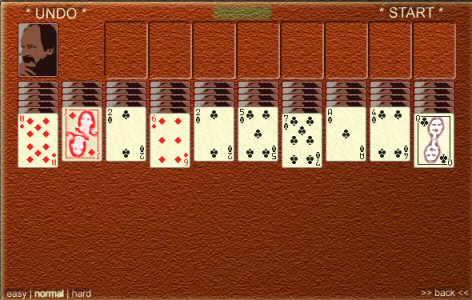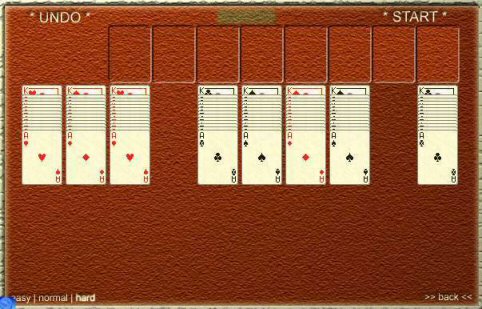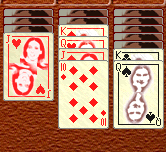Mogelpat
Mogelpat (Originalregel)
Object of the Game
Mogelpat is a version of Patience. The goal of the game is to uncover and sequence all cards according to their suits, using the work stacks.
Game board

Mogelpat Patience can be played in three stages of Difficulty: easy (1 card suit), normal (2 card suits), or hard (all 4 suits). To change Difficulty, simply click your choice in the lower left corner before play.
To begin playing, simply click on the START button in top right. The cards are mixed and laid out (Example shown on the left).
In this game, there are three locations for cards:
- 1 distribution deck - top left. All cards not laid out yet are in the deck.
- 8 auxiliary piles - top right and empty at beginning of game
- 10 work stacks - bottom row of cards.
At the beginning of the game, there are 50 cards in the distribution deck and 54 cards in the work stacks.
Flow of the game
Aim of the Game
The goal of the game is to uncover and sequence all cards according to their suits, using the work stacks. The end of the game could look like this image, but this is just one example:

To accomplish this, colored suits in Sequence may be moved around. Note: An individual card is colored partial sequence. However, cards or sequences may be put only on an empty work stack area, or where a new sequence can develop - this does have to be the same color suit.
ANNEX

In this example, the 10 of Diamonds can be moved alone to the Jack of Hearts beside it. Or, the Jack and 10 of Diamonds can be moved together, to either an empty work stack (not shown) or to the Queen of Spades. In that case, the Queen of Hearts would be uncovered (in the middle stack) and the Jack of Hearts could then be moved to the Queen of Hearts stack. The Queen of Hearts and the two Diamonds cannot be moved together, because although it's a sequence, it is not a proper Suited Sequence.
Moving cards is done by pulling the highest card of the sequence using the mouse to the new location. Or, if you click the highest card of the sequence with the mouse, a suitable location is determined automatically (but not necessarily the best location).
If the last uncovered card of a work stack is moved to another position, then the highest covered card is uncovered automatically. In our example above, if we moved the Jack of Hearts to the Queen of Hearts, a new card under the Jack's old location would be uncovered. On all work stacks, additional cards may be uncovered by distributing from the Distribution Deck.
Auxiliary pile
Completed Suited Sequences (i.e. from the King to the Ace) can be moved to an empty auxiliary pile. This creates more empty space within the work stacks, which simplifies sequencing of the remaining cards.
Careful: Sequences cannot be retrieved back from the auxiliary piles to the work stacks. When calculating points, there are special points for complete sequences which lie alone on the work stacks (like the example above).
Undo
Patience is difficult to complete, and rare according to normal Patience rules. Therefore to help counter this difficulty, we have an Undo button on the top left of the screen. With this Undo, single or multiple movements can be taken back (even back to the beginning of the Patience game). Using the Undo button doesn't affect directly your score. However, since your final point calculation is affected by your time, there is an indirect (time) punishment if you use the Undo many times.
End of the Game
The game ends, when all cards are sorted and sequenced according to their suit, or by clicking the STOP button at top right.
Scoring
Scoring depends both on the time and on the selected degree of difficulty. Using the auxiliary piles affects the point assessment negatively.

